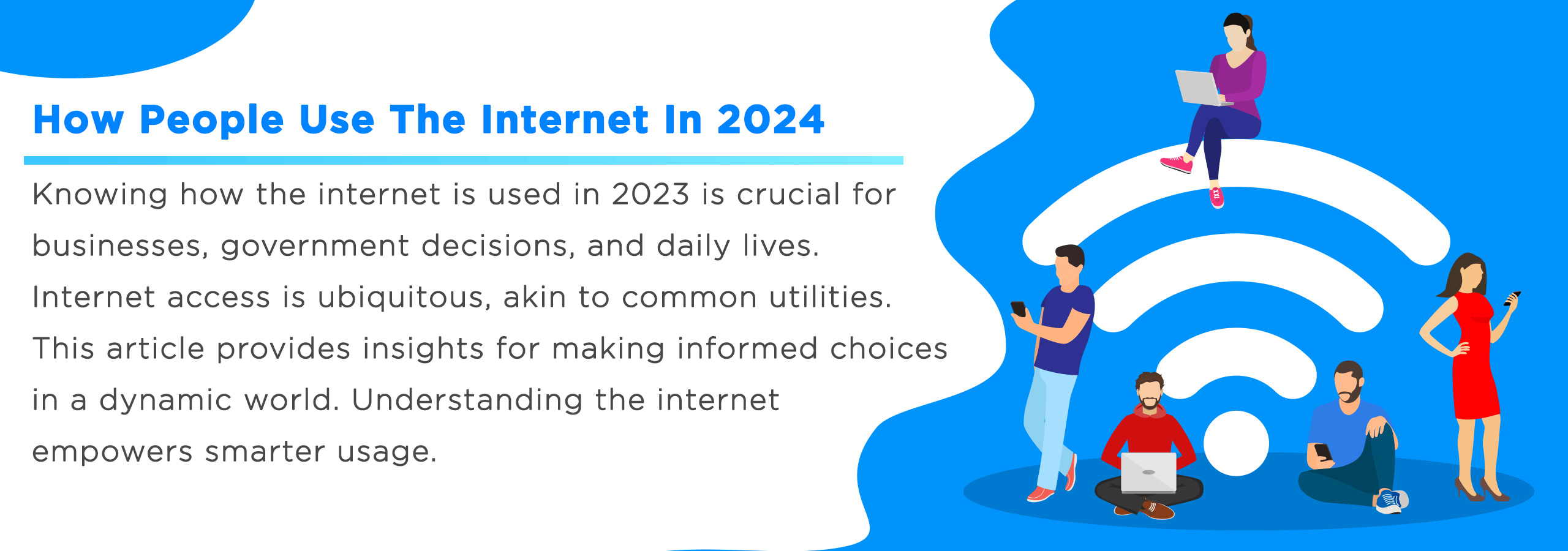Understanding how we all use the internet in 2024 is more than just interesting; it's vital for businesses, government decisions, and the daily lives of billions of people. And in most places, internet access is as common (and perhaps as necessary) as common utilities.
This article is here to give you the lowdown on how people use the internet in 2024. Whether you're running a business, making rules, or just surfing the web, we want you to make smart choices in a world that's always changing. Once you know more about the internet, you know more about how to use it.
Internet Access
Global Internet Access
In the past year, the Internet is now within reach for around 64.6 percent of the world's population, totaling about 5.18 billion people. Among these, a significant portion, about 61.4 percent, actively engage with social media platforms, amounting to approximately 4.95 billion users globally.
Types of Internet Connections
Fiber-optic:
- A 2022 study by the Fiber Broadband Association (FBA) revealed that over 60 million homes in the U.S. are now connected to fiber-optic networks. This marks a 12 percent increase from the approximately 54 million homes connected in 2020.
4G LTE:
- In January 2022, 4G LTE was in use by 66 percent of mobile users, as reported by the Global Mobile Suppliers Association (GSA). This represents 6.6 billion subscriptions, connecting approximately two-thirds of mobile users worldwide.
5G:
- Based on a recent report by GSA, 5G subscriptions currently make up 10.7 percent of the world's total mobile subscriptions. This percentage is expected to increase to 16 percent by the end of last year, with approximately 1.77 billion people using 5G services.
Satellite:
- Satellite internet currently serves over 43 million people globally through various providers, with projections indicating an increase to 110 million users by 2029.
DSL (Digital Subscriber Line):
- DSL networks are accessible to nearly 90% of the US population, with coverage extending to over 70% of individuals residing in rural regions.
Rural vs. Urban Internet Access
The 2022 research from the International Telecommunication Union reveals that 82 percent of urban residents worldwide have internet access, which is 1.8 times higher than the percentage of rural internet users. However, it is a decrease from 2.3 times higher as of three years ago.
In Europe, this gap has almost disappeared with a ratio of 1.1 between urban and rural internet users. In other regions, the gap remains wide but is narrowing. For example, in Africa, 64% of urban residents use the Internet compared to 23% in rural areas, with a ratio of 2.8, down from nearly 4 in 2019. In the Asia-Pacific region, the ratio is 1.8, a reduction from 2.4 three years ago.
Demographics of Internet Users
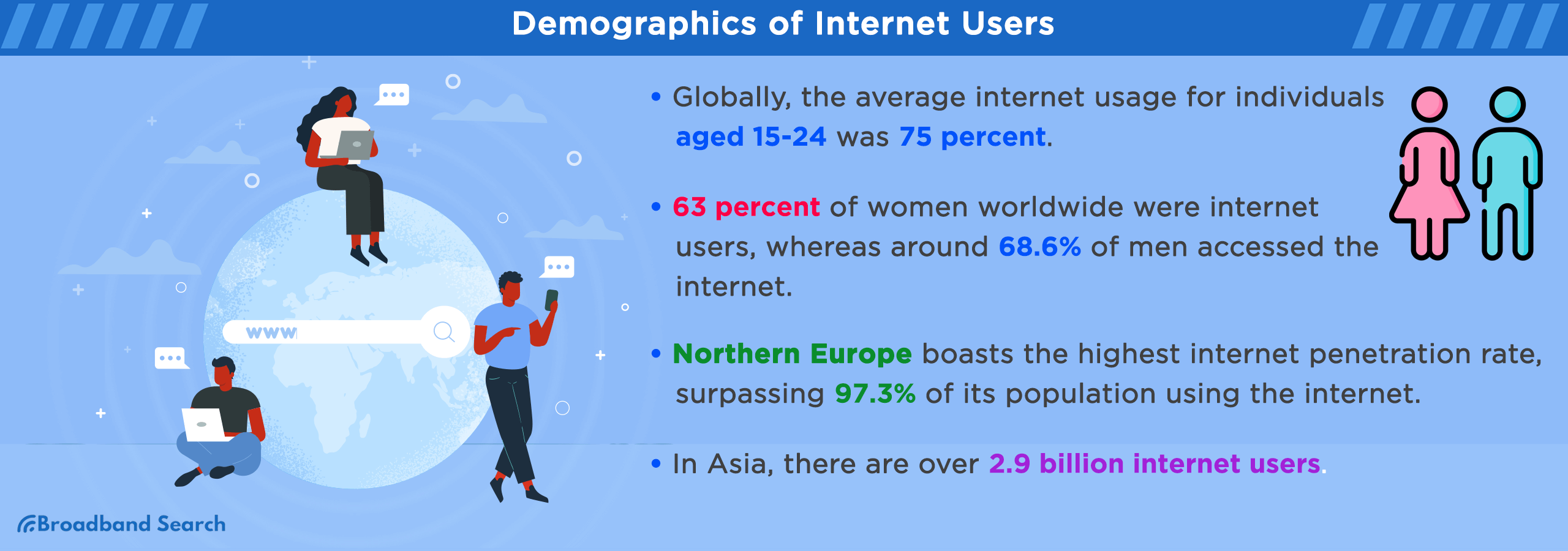
Age Distribution
In 2022, Statista's data shows that the age group of 15-24 had the highest global internet usage, with Europe leading at a 98 percent usage penetration among young people. Globally, the average internet usage for individuals aged 15-24 was 75 percent.
Gender Distribution
By October of last year, global internet usage among women was slightly lower than among men. The data reveals that approximately 63 percent of women worldwide were internet users, whereas around 68.6% of men accessed the internet.
Global internet usage in October of last year exhibited a slight gender difference, with around 63% of women worldwide using the internet compared to approximately 68.6% of men.
In terms of online activities, men tend to use the internet more for checking the weather, getting news, finding do-it-yourself information, sports updates, political and financial information, job-related research, software downloads, music listening, rating products/services through online reputation systems, downloading music files, using webcams, and taking online classes.
Conversely, women are more inclined than men to use the internet for sending and receiving emails, obtaining maps and directions, searching for health and medical information, seeking online support for health or personal matters, and accessing religious information.
Geographical Distribution
- Northern Europe boasts the highest internet penetration rate, surpassing 97.3% of its population using the internet, according to Statista.
- Western Europe closely follows with a penetration rate of 93.7%.
- In Asia, there are over 2.9 billion internet users, with the largest user base concentrated in East Asia.
Internet Usage Patterns
Daily Internet Usage Duration
In recent findings from Statista, it was revealed that females aged 16-24 spent the most time online, averaging about seven hours and 36 minutes per day. Males in the same age group spent slightly less time, approximately seven hours and one minute daily. Meanwhile, individuals aged 55-64 were among the least active online users (though still spending quite a bit of time online), spending an average of up to five hours and 18 minutes online each day.
Frequency of Internet Usage
Daily:
Globally, 5.07 billion people use the internet daily, demonstrating a remarkable 6.2 percent year-to-year growth rate in the past year, the fastest since 2019.
Weekly:
In Italy, during 2022, more than 93 percent of teenagers aged 15 to 17 accessed the internet daily, while a little less than five percent used it at least weekly.
Primary Devices Used for Internet Access
The devices people use to access the internet vary widely, with mobile phones being the most common choice. Here's a breakdown of the primary devices for internet access:
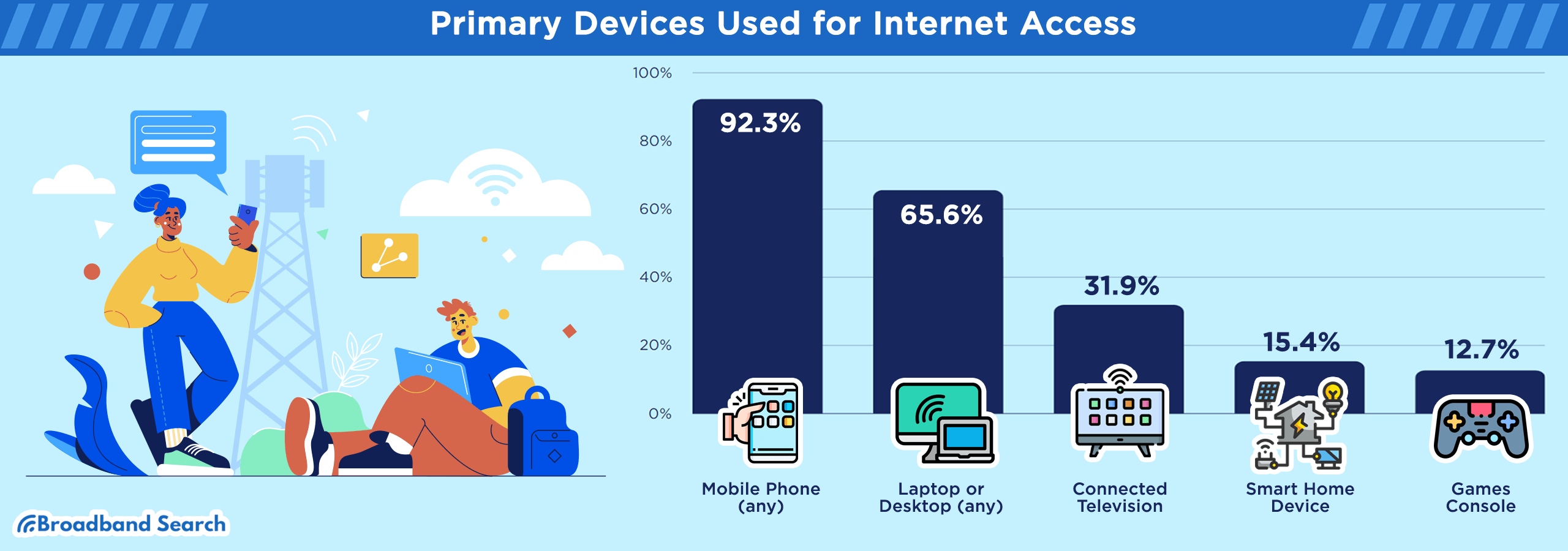
Time of Day Internet is Most Commonly Used
Internet usage peaks during the evening, typically from 7:00 p.m. to 9:00 p.m., when people return home from work or school and engage in activities like streaming, gaming, and using social media. These hours often experience network congestion due to high demand.
Online Activities
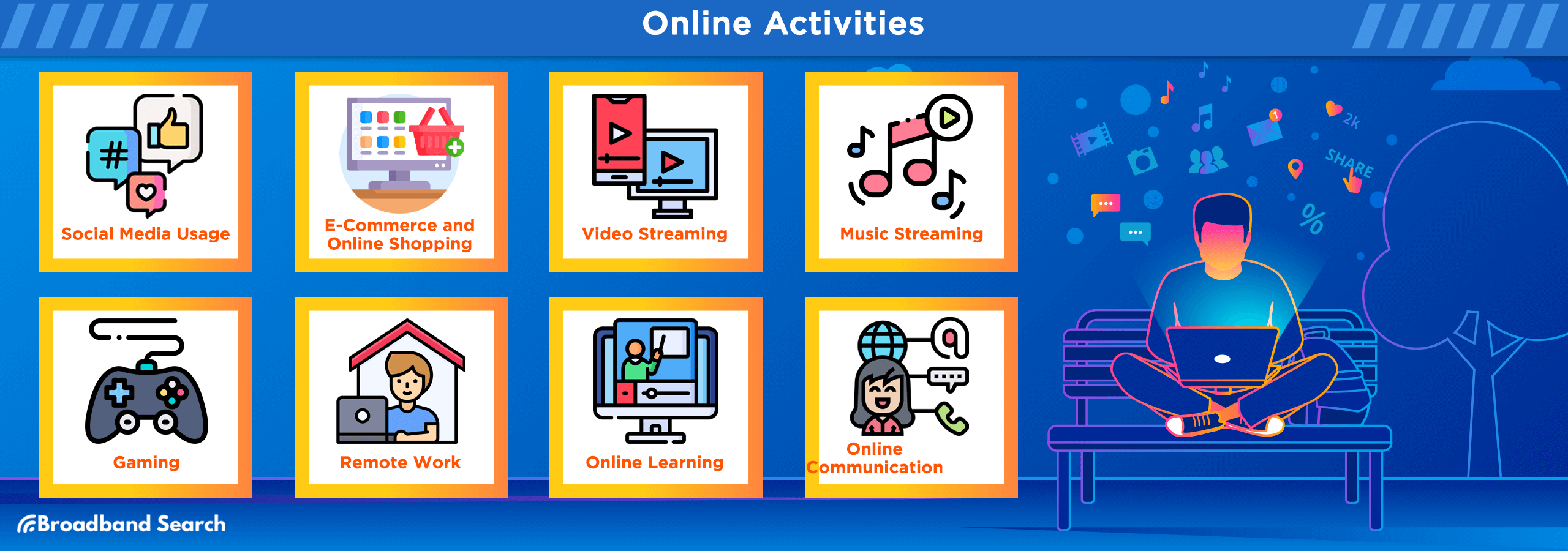
Social Media Usage
Facebook:
- In the third quarter of last year, Facebook boasted 2.08 billion daily active users, marking a minor increase from the previous quarter. When examining the number of daily active users in the second quarter of 2022, the platform had gained around 96 million additional users.
Instagram:
- Recent statistics confirm that Instagram now has more than 2 billion people using the platform every month. Furthermore, it enjoys the active participation of over 500 million users daily.
X (Twitter):
- Twitter's (now X’s) user base in the past year comprises 528.3 million monetizable monthly active users, which is expected to grow to 652.23 million by 2028. Additionally, Twitter has 237.8 million monetizable daily active users.
TikTok:
- TikTok reached 1.5 billion monthly active users in the past year, with more than 780 million users accessing it (or rather its counterpart Douyin) daily in China.
Snapchat:
- Statista recently revealed that Snapchat's daily active user count globally rose from 397 million in the second quarter of 2023 to 406 million in the third quarter of 2023.
LinkedIn:
- LinkedIn's recent data has shown that 48 percent of its users are active monthly, with over 16 percent logging in daily. This translates to a substantial daily user count of 141 million individuals.
WhatsApp:
- As of March last year, WhatsApp boasts a massive global user base of over two billion monthly active users. Among these, India stands out with the highest number of monthly active users, totaling 390.1 million.
YouTube:
- YouTube's monthly user base exceeds 2.70 billion people, with 52 percent of global internet users visiting the platform at least once a month. Furthermore, YouTube Premium has garnered 80 million active users worldwide.
E-Commerce and Online Shopping
Online shopping has witnessed substantial growth in recent years and is expected to continue expanding. Notably, Amazon, Walmart, eBay, and AliExpress are among the top e-commerce sites, attracting significant visitor traffic.
As explained by Oberlo, global e-commerce sales are projected to reach $6.3 trillion in 2024, reflecting a 9.4 percent increase in 2023. In the United States, Statista reports that there were 268 million online shoppers in 2022, rising to 285 million by 2025. While there's a difference in the percentage of males (68 percent) and females (72 percent), it's important to note that both genders contribute significantly to the thriving e-commerce industry.
Streaming and Entertainment
Video Streaming
In September of last year, statistics revealed that streaming constitutes a significant portion of TV usage, accounting for 38.1 percent of all viewing.
The popularity of video streaming is evident with approximately 1.8 billion subscriptions to such services globally. In the U.S., a staggering 83 percent of households have at least one streaming service subscription. Netflix boasts well over 200 million subscribers worldwide as of last year.
Binge-watching has become a common habit, as 26 percent of viewers admit to indulging in it at least once a week.
Music Streaming
In the previous year, the most popular online music services in the United States were Spotify, YouTube Music, and Pandora, with 37, 21, and 14 percent of survey respondents respectively having recently used them. Meanwhile, Apple Music and Amazon Music needed to catch up, with only 11 percent and 7 percent of participants using each service in the past month.
Spotify's global presence continued to grow, with 220 million premium subscribers worldwide in the second quarter of last year, compared to 188 million in the same quarter of 2022. Moreover, Spotify's monthly active users reached 515 million, reflecting a five percent increase from the previous quarter and a notable 22 percent rise from the same period last year.
A 2023 IFPI Global Music Report revealed that paid music streaming accounted for 23 percent of all music consumption, contributing significantly to the industry. Globally, a substantial 67 percent of total music industry revenue came directly from music streaming platforms, while physical sales constituted just 16.1 percent. Approximately 4 out of 5 people worldwide now use music streaming services, totaling about 78 percent of music listeners.
By the fourth quarter of last year, music streaming maintained its popularity, with 78 percent of people opting for streaming services as their primary music source. Over 600 million individuals worldwide subscribed to music streaming platforms, which now make up a remarkable 84 percent of music industry revenue.
Gaming
As of the fourth quarter of the previous year, there are a staggering 2.7 billion active gamers worldwide, accounting for approximately 33.5 percent of the global population. The average gamer is more likely to be an adult, with 36 percent falling in the 18 to 34 age group. Only around 24 percent are under 18. Gender-wise, there's almost an equal split, with males comprising 52 percent and females 48 percent of gamers.
When it comes to gameplay, the average person spends about 8.45 hours per week on video games, with binge-gaming sessions lasting around 5.1 hours. Notably, gamers in China lead the pack, dedicating an average of 12.39 hours per week to gaming.
As mentioned in a report by the BBC, there is a significant shift towards digital purchases in the UK, with approximately 89.5 percent of video game acquisitions being digital downloads.
Online Learning and Work
Remote Work:
Last year, the landscape of work has evolved significantly. Forbes reports that 12.7 percent of full-time employees now work from home while 28.2 percent follow a hybrid model. This trend extends to employers, with a remarkable 93 percent planning to continue conducting job interviews remotely. Moreover, around 16 percent of companies have already embraced fully remote operations, eliminating the need for physical offices.
Within the age group of 24 to 35 remote work finds its stronghold, with 39 percent working remotely full-time and an additional 25 percent adopting part-time remote work.
Online Learning:
Forbes highlights the substantial presence of online education, with online colleges and universities enrolling nearly 2.79 million students, representing almost 15 percent of all postsecondary learners in the United States. Female students comprise the majority, accounting for about 62 percent of all online learners. Additionally, nearly 8.5 million U.S. students are engaged in online classes offered by public higher education institutions.
Research conducted by the University of the Potomac indicates that 70 percent of students favor online classes over traditional classroom settings. Moreover, data from the UK's Higher Ed Partner reveals a significant shift since 2020, with 98 percent of universities transitioning their classes to an online format.
Online Communication
Email:
Statista reported that as of 2022, there were approximately 4.26 billion global email users, and this number is expected to increase to 4.73 billion by 2026. During the same year, an estimated 333 billion emails were sent and received worldwide every day. Projections indicate that this volume is set to rise to 392.5 billion daily emails by 2026.
Messaging:
In January of last year, WhatsApp had an impressive user base of two billion monthly users. The app's widespread popularity is particularly notable in markets beyond the United States, where it stands as one of the world's most favored mobile social apps. WeChat boasted over 1.3 billion users, while Facebook Messenger secured around 930 million users globally.
Furthermore, in June of last year, mobile instant chat and WhatsApp took the lead as the most downloaded mobile messenger app worldwide, with nearly 46 million downloads. Telegram followed closely in second place with approximately 34.3 million downloads, and Snapchat ranked third with approximately 32 million downloads.
Video Conferencing:
Zoom dominates the video conferencing market, boasting a 40.49 percent market share. Impressively, 89 percent of Zoom users rely on the platform for business meetings. Notably, 24 percent of Zoom app downloads are attributed to individuals aged 35 to 49.
Statista's data of april last year revealed that Zoom.us had approximately 810.2 million unique global visitors, slightly down from the previous month's 943 million.
Internet Security and Privacy
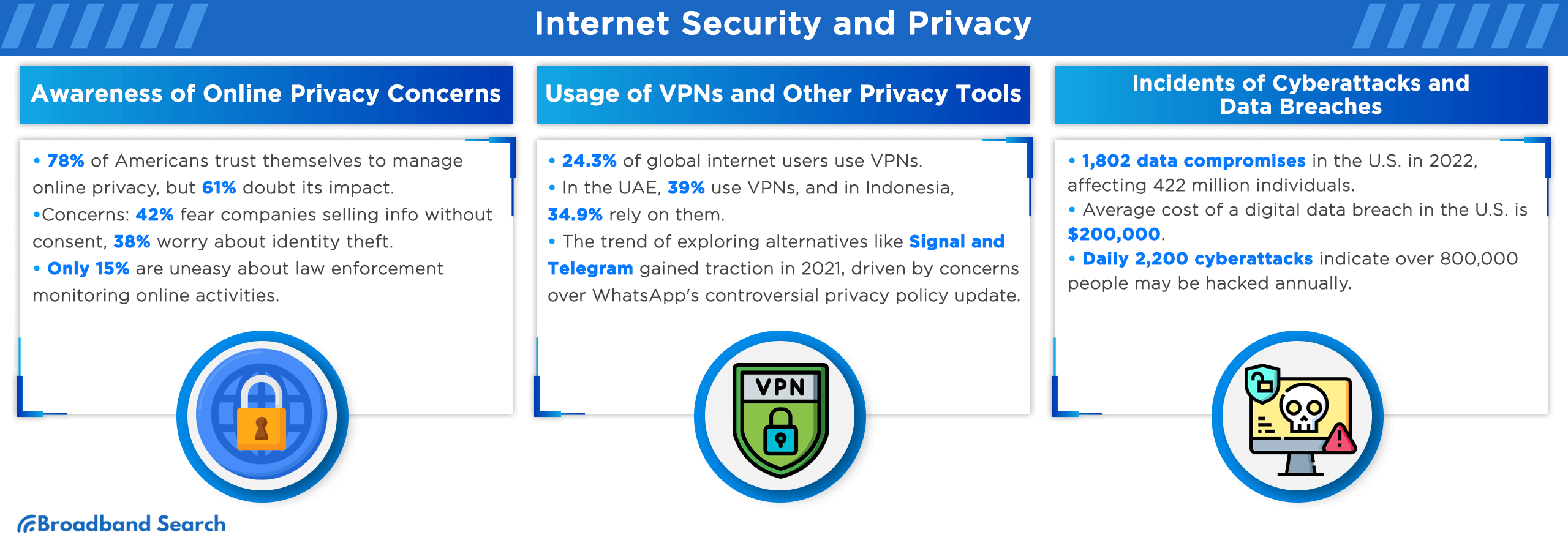
Awareness of Online Privacy Concerns
As indicated in a recent Pew Research Center study, when it comes to managing their online privacy, 78 percent of Americans trust themselves to make the right decisions about their personal information. However, a majority, 61 percent, are skeptical that their actions will have any meaningful impact.
The study also reveals that specific concerns vary among Americans. Approximately 42 percent are very worried about companies selling their information without their knowledge, and 38 percent express concern about identity theft or personal information theft. In contrast, fewer Americans, only 15 percent, are apprehensive about law enforcement monitoring their online activities.
In a separate Pew survey in May of last year, focusing on 802 teenagers, the study delves into teens' privacy management on social media platforms.
Among teen Facebook users:
- 60 percent have set their profiles to "private," allowing only approved friends to view their content.
- 25 percent maintain partially private profiles, granting access to friends of friends.
- 56 percent find managing Facebook privacy settings "not difficult at all."
- 33 percent consider it "not too difficult."
- Only 8 percent describe it as "somewhat difficult."
- Less than 1 percent find it "very difficult."
Usage of VPNs and Other Privacy Tools
More than 24.3 percent of internet users worldwide utilize virtual private networks (VPNs). In the United Arab Emirates, nearly 39% of internet users employ VPNs for various online activities. Indonesia comes second in VPN usage, with approximately 34.9 percent of its online users relying on VPNs during the measured period.
Furthermore, in August of the past year, the mobile messaging app Signal recorded nearly 3.74 million downloads in Europe, the Middle East, and Africa, reflecting a growing interest in alternative messaging platforms like Signal and Telegram. This trend gained traction in 2021 as users sought alternatives to WhatsApp following a controversial privacy policy update.
Incidents of Cyberattacks and Data Breaches
Statista's latest data indicates that in 2022, there were 1,802 recorded cases of data compromises in the United States. These compromises impacted a staggering 422 million individuals, encompassing various forms of data breaches, leaks, and exposures.
Each year, an alarming 111.7 million Americans fall victim to hacking incidents, translating to approximately one in three individuals experiencing a data breach annually. These breaches are often attributed to weak usernames, passwords, and limited digital literacy.
Notably, the average cost of a digital data breach in the U.S. amounts to $200,000 for companies, irrespective of their size. Despite increased efforts by American companies to bolster their cybersecurity measures, the frequency of breaches continues to climb.
While precise annual figures on the number of individuals affected by cyberattacks remain elusive, the daily occurrence of around 2,200 cyberattacks implies that more than 800,000 people may be hacked each year, underscoring the pervasive nature of cyber threats.
Internet and Mental Health
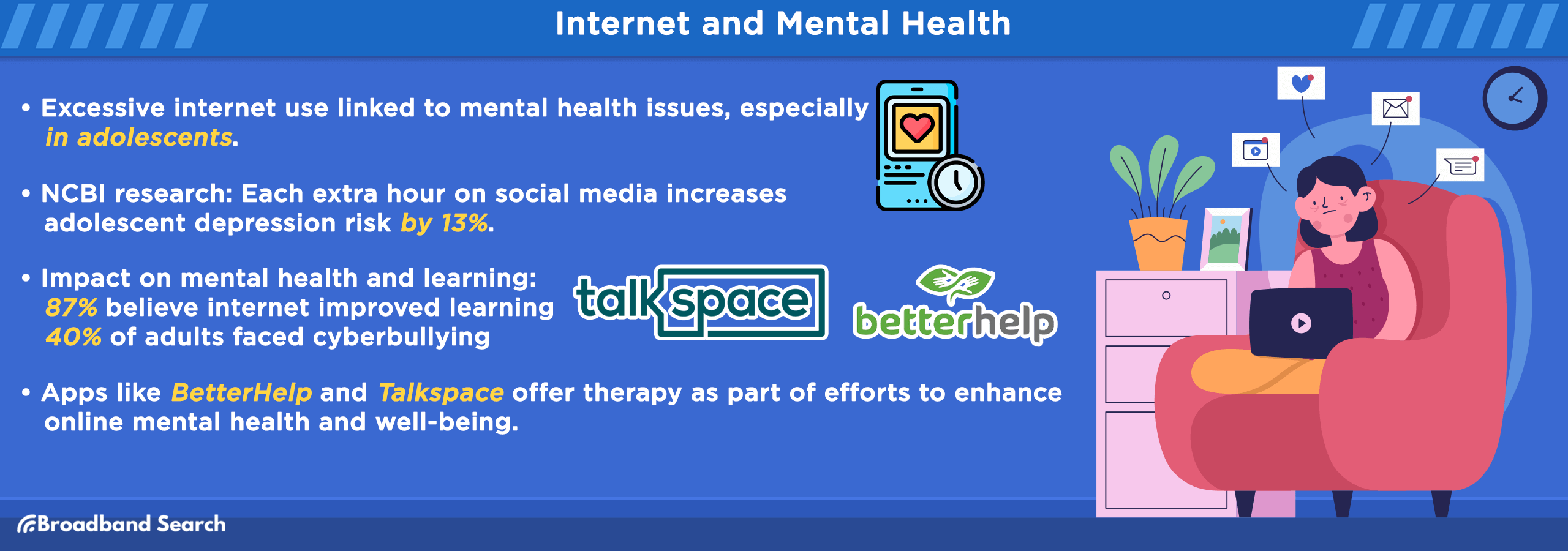
Impact of Internet Usage on Mental Health
Excessive internet use has been linked to mental health issues, particularly among adolescents. Research from the National Center for Biotechnology Information (NCBI) reveals that for each additional hour of social media use, the risk of depression in adolescents increases by 13 percent. Furthermore, studies emphasize the connection between excessive social media usage and feelings of isolation and depression.
The Internet can have a positive impact on mental health and learning, as indicated by a Pew Research Center survey of 1,066 Internet users:
- About 87 percent believe the internet and cell phones have improved their ability to learn new things.
- Among these respondents, 53 percent reported significant improvement.
- Additionally, 72 percent of internet users appreciate the convenience of having easy access to information.
- Only 26 percent feel overwhelmed by the vast amount of data available.
Percentage of Users Who Have Experienced Online Harassment or Cyberbullying
Online harassment and cyberbullying continue to be significant concerns, affecting a substantial portion of internet users. Statista's research indicates that 40 percent of adult internet users have personally encountered cyberbullying at some point in their lives.
According to the Pew Research Center's survey, certain demographic groups, including women and young adults, are more susceptible to online harassment.
- Women are notably more likely than men to report online sexual harassment, with 16 percent of women experiencing it, compared to five percent of men.
- Similarly, 13 percent of women report being stalked online, whereas 9 percent of men report the same.
- Young women, in particular, face a higher risk, with 33 percent of those under 35 reporting experiences of online sexual harassment, compared to 11 percent of men under 35 who report the same.
Efforts to Promote Online Mental Health and Digital Well-Being
Efforts to promote digital well-being have gained momentum. Companies like Google and Apple have introduced digital well-being features that allow users to monitor screen time and set app limits. Additionally, mental health apps like BetterHelp and Talkspace offer convenient access to therapy and counseling services.
Online mental health initiatives, such as Crisis Text Line and 7 Cups, provide 24/7 support for those in crisis. These efforts, combined with increased awareness, aim to create a safer and more supportive online environment for users.
Emerging Technologies
Adoption of Internet of Things (IoT) Devices
The rise of IoT devices has been nothing short of remarkable, reshaping both homes and industries. In the past year, the global count of IoT devices stands at a staggering 15.14 billion. These devices have found their place in various realms, such as smart homes, where they elevate convenience and security, and connected healthcare, where they play a crucial role in monitoring and transmitting health data for remote patient care.
Interest and Usage of Augmented Reality (AR) and Virtual Reality (VR)
AR and VR technologies are making significant strides, reshaping the tech landscape. The augmented reality market is projected to grow from $25.1 billion in 2023 to $71.2 billion by 2028, with a compound annual growth rate (CAGR) of 23.2% during this period. Similarly, the virtual reality market is expected to increase from $12.9 billion in 2023 to $29.6 billion by 2028, exhibiting a CAGR of 18.0% from 2023 to 2028.
Notably, VR-based training has demonstrated remarkable efficacy, boosting learner confidence by up to 275 percent, surpassing traditional classroom and e-learning methods by 40 percent and 35 percent, respectively.
Usage of Voice Assistants and Smart Home Technology
Voice-activated assistants like Amazon Alexa, Google Assistant, and Apple Siri have seen widespread adoption. In the United States alone, 36.6 percent of adults use voice assistants, and this number continues to rise. These assistants are at the heart of smart home technology, where they control lighting, thermostats, security systems, and more. The global smart home market is expected to reach $174.2 billion by 2025, indicating substantial interest and integration of this technology into households.
Future Predictions and Trends
Expected Changes in Internet Usage
Experts predict several significant shifts in internet usage patterns in the coming years. One key trend is the exponential growth of Internet of Things (IoT) devices, which are expected to become increasingly integrated into households and industries. By 2030, it is estimated that there will be approximately 29.42 billion IoT devices worldwide, up from 15.14 billion in the past year, based on predictions by Statista. This proliferation will drive increased connectivity and data generation.
Additionally, the adoption of 6G networks is expected to revolutionize internet connectivity. These networks are projected to offer unprecedented speed and reliability.
Anticipated Shifts in Online Behavior and Technology Adoption
We can expect a shift towards niche social media platforms and specialized content consumption. Many individuals are taking a break from larger platforms like Facebook and Instagram due to the increased negativity found there. Instead, they are turning to smaller, niche networks where they can connect with specific, like-minded communities. This shift reduces the online noise and allows users to focus on the content that truly interests them. For brands, niche platforms offer a valuable opportunity to build communities and connect with genuinely interested audiences.
These niche social platforms hold great promise, as they cater to unique communities in ways that mainstream platforms cannot. It's not just a passing trend; it represents a fundamental change in how we engage and connect online. By fostering shared interests, meaningful interactions, and tailored experiences, these communities are shaping the digital landscape of the future.
Moreover, advancements in artificial intelligence (AI) and machine learning will play a pivotal role in shaping online behavior. AI-driven content recommendations, chatbots, and personalized services will become more prevalent.
The Bottom Line
The internet, always evolving, offers opportunities and challenges. Younger generations drive trends in gaming, streaming, and social media. It transforms sectors like remote work, online education, e-commerce, and entertainment. Mobile access is key, with evening peak usage, emphasizing network optimization. Online security and privacy remain concerns.
Emerging tech like IoT, AR, VR, and voice assistants foster innovation. Navigating this landscape requires addressing disparities and promoting responsible digital citizenship. Businesses need mobile-friendly, secure, and personalized websites. Policymakers should ensure universal access, data protection, and online safety. Individuals must use the internet wisely, safeguard data, and be aware of risks. In this ever-changing internet world, adaptation, fairness, and safety are vital.
FAQ
What are the key internet usage patterns among different age groups?
Internet usage patterns vary across age groups, with younger individuals (15-24 years) being the most active users. They dominate activities like gaming, streaming, and social media engagement.
What are the most popular devices for accessing the internet?
The most popular devices for accessing the internet are mobile devices, including smartphones and tablets.
What are the implications of internet usage trends for businesses?
The implications for businesses are that they should prioritize mobile optimization, cybersecurity, and personalized content to enhance customer engagement in the digital landscape.
What responsibilities do policymakers have with internet usage patterns?
Policymakers need to address the digital divide, enforce data privacy regulations, and promote cybersecurity measures to protect citizens' interests.
What emerging technologies are impacting internet usage patterns?
Emerging technologies such as the Internet of Things (IoT), Augmented Reality (AR), Virtual Reality (VR), and voice assistants are shaping the future of Internet usage.

